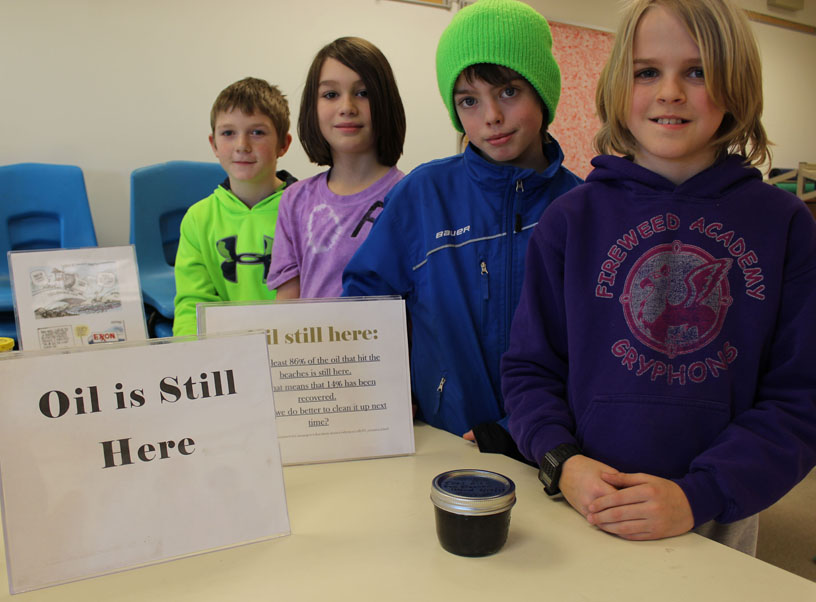They might not have been born when it happened, but ask the fifth- and sixth-grade students at Fireweed Academy about the Exxon Valdez oil spill and related topics and they can give you answers.
Better yet, on Wednesday, Feb. 5, from 3-5 p.m., visit the Alaska Islands and Ocean Visitor Center where the students will display a Discovery Lab they created with help from the Kachemak Bay Research Reserve, Prince William Sound Regional Citizens’ Advisory Council, the Alaska Department of Fish and Game and some private citizens.
“It all started when we got a small grant from Prince William Sound (Regional) Citizens’ Advisory Council. They’re the oil spill people and they have the money for education,” said KBRR’s Catie Bursch. “They really like the Discovery Labs we have and we had the idea of asking a school class if it would like to put on a Discovery Lab given a topic. The topic that came with the funding was ‘oil spill science.’”
The mission of the citizens’ advisory council is “citizens promoting environmentally safe operations of the Alyeska Pipeline marine terminal in Valdez and the oil tankers that use it.” The opportunity to create a Discovery Lab fit in with Fireweed’s “communication” theme for the second quarter of the school year and the current theme of “currents.”
“It also is a good match for our constructivist approach, as students build an understanding of what led to this event, the implications of the event itself, at the time as well as long-term,” said Fireweed teacher Kris Owens. “They constructed knowledge related to petroleum science, clean-up methods and impacts (economic, social and environmental).”
As Bursch pointed out, the topic the students were given could go in a lot of different directions. They chose to break it down in several sub-topics: general facts and background of the Exxon Valdez oil spill presented via a board game, oil spill clean-up methods, impacts on wildlife, impacts on beaches and coastal lands, currents and the spread of oil, double-hulled vessels, effects of crude oil on humans and long-term effects on animals resulting from the spill.
The material has been prepared around a Discovery Lab “formula” that has proven to work. It includes hands-on activities, photos and easy-to-understand graphics.
On Tuesday, the students timed how long it took each group to set up their presentations and displays in preparation of the Discovery Lab on Feb. 5. Then they visited each other’s displays, asking questions, offering suggestions.
“We gave them some information to pique their interest, explained how to set up a Discovery Lab table, and then I’ve been going into the school probably once every other week as the winter’s been involving,” said Bursch. “They’re pretty excited about the topic.”
Final presentations are Owens’ way of evaluating what the students have learned through the project.
Self-evaluation is another avenue she uses, with the students listing lessons learned that encompass
Cassidy Wylde: (The Exxon Valdez crew) wasn’t steering properly.
Terry Gilliland: Oil is still on the beaches.
Katlyn Wogl: How much currents move the oil and make cleanup difficult, how scientists learned from this to predict movement oil in a spill.
Brita Restad: Not all species of animals have recovered; what kind of soap is used in an oil-spill cleanup.
Austin Cline: Oil seeps, which happen naturally, put more oil in the water than an oil spill.
Ian Cambridge: I learned of the impacts of the BP spill in the Gulf of Mexico.
Ruby Allen: How to make an infographic.
Laura Inama: How to incorporate graphs into a project.
McKibben Jackinsky can be reached at mckibben.jackinsky@homernews.com.


